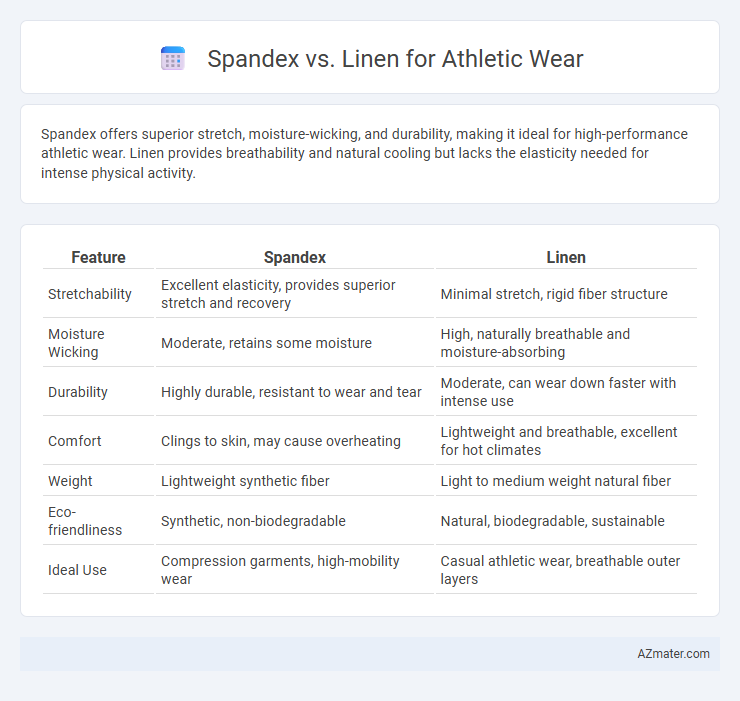Spandex offers superior stretch, moisture-wicking, and durability, making it ideal for high-performance athletic wear. Linen provides breathability and natural cooling but lacks the elasticity needed for intense physical activity.
Table of Comparison
| Feature | Spandex | Linen |
|---|---|---|
| Stretchability | Excellent elasticity, provides superior stretch and recovery | Minimal stretch, rigid fiber structure |
| Moisture Wicking | Moderate, retains some moisture | High, naturally breathable and moisture-absorbing |
| Durability | Highly durable, resistant to wear and tear | Moderate, can wear down faster with intense use |
| Comfort | Clings to skin, may cause overheating | Lightweight and breathable, excellent for hot climates |
| Weight | Lightweight synthetic fiber | Light to medium weight natural fiber |
| Eco-friendliness | Synthetic, non-biodegradable | Natural, biodegradable, sustainable |
| Ideal Use | Compression garments, high-mobility wear | Casual athletic wear, breathable outer layers |
Introduction to Spandex and Linen in Athletic Wear
Spandex is a synthetic fiber known for its exceptional elasticity, making it ideal for athletic wear that requires stretch and flexibility. Linen, a natural fiber derived from flax plants, offers breathability and moisture-wicking properties but lacks the stretch and recovery capabilities of spandex. Combining spandex with linen can enhance comfort and performance by blending durability with flexibility in athletic apparel.
Fabric Composition: Spandex vs Linen
Spandex is a synthetic fiber known for its exceptional elasticity, often blended with polyester or nylon to enhance stretch and moisture-wicking properties in athletic wear. Linen, a natural fiber derived from flax plants, offers breathability and moisture absorption but lacks the flexibility required for intense physical activity. Fabric composition in athletic wear favors spandex blends for durability, shape retention, and comfort during movement, whereas linen is typically reserved for casual or low-impact apparel due to its limited stretch and slower drying time.
Breathability and Moisture Management
Spandex offers excellent moisture management by wicking sweat away from the skin, making it ideal for high-intensity workouts, while its stretch properties enhance mobility. Linen, renowned for its natural breathability and lightweight weave, allows superior air circulation, keeping the body cool during moderate activity. Combining spandex with linen can optimize athletic wear by balancing moisture control and ventilation for improved performance and comfort.
Stretch and Flexibility Comparison
Spandex offers superior stretch and flexibility, providing up to 500% elongation without losing shape, making it ideal for high-movement athletic activities. Linen, made from flax fibers, lacks significant elasticity, resulting in limited stretch and reduced range of motion during intense workouts. For athletes prioritizing maximum flexibility and support, spandex-based fabrics deliver enhanced performance compared to linen's rigid structure.
Comfort and Skin Sensitivity
Spandex offers exceptional stretch and moisture-wicking properties, making it ideal for athletic wear by providing superior comfort and freedom of movement. Linen, while breathable and lightweight, can feel rougher against sensitive skin and lacks the elasticity needed for high-performance activities. Athletes with sensitive skin often prefer spandex blends to avoid irritation and ensure sustained comfort during intense workouts.
Durability and Longevity
Spandex offers exceptional durability and elasticity, making it ideal for athletic wear that requires frequent stretching and dynamic movement. Linen, while breathable and lightweight, tends to wear down faster under rigorous physical activity due to its natural fibers and lower resistance to abrasion. Choosing spandex-based fabrics ensures longer-lasting performance and shape retention in high-intensity sports and workouts.
Maintenance and Care Requirements
Spandex requires gentle care, typically hand washing or machine washing on a delicate cycle with cold water to maintain elasticity and prevent damage. Linen, although breathable and natural, needs more careful handling to avoid shrinking and wrinkling, often requiring gentle washing and ironing while damp. Athletic wear with spandex offers durability with minimal maintenance, whereas linen demands more frequent attention to retain its texture and fit.
Environmental Impact and Sustainability
Spandex, a synthetic fiber derived from petroleum, has significant environmental drawbacks including non-biodegradability and high energy consumption during production, making it less sustainable for athletic wear. Linen, made from flax plants, is biodegradable, requires less water and pesticides compared to cotton, and supports sustainable agriculture, positioning it as an eco-friendly alternative. Choosing linen over spandex reduces carbon emissions and chemical waste, aligning better with green athletic wear initiatives.
Popular Uses in Athletic Clothing
Spandex is widely used in athletic wear for its exceptional stretch and recovery properties, making it ideal for compression garments, yoga pants, and performance leggings that require flexibility and support. Linen, although breathable and moisture-wicking, is less common in high-intensity athletic clothing but is favored in casual sportswear and summer workout gear for its lightweight and natural cooling effects. The combination of spandex with other fibers enhances durability and movement, while linen blends offer comfort for low-impact activities.
Choosing the Right Fabric for Your Workout
Spandex offers exceptional stretch and moisture-wicking properties, making it ideal for high-intensity workouts requiring flexibility and breathability. Linen, while highly breathable and lightweight, lacks the elasticity needed for dynamic movements but excels in low-impact activities and hot weather conditions. Choosing between spandex and linen depends on workout intensity and comfort preferences, with spandex favored for performance and linen for natural ventilation.

Infographic: Spandex vs Linen for Athletic Wear
 azmater.com
azmater.com